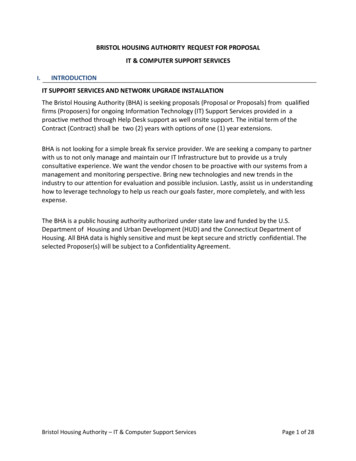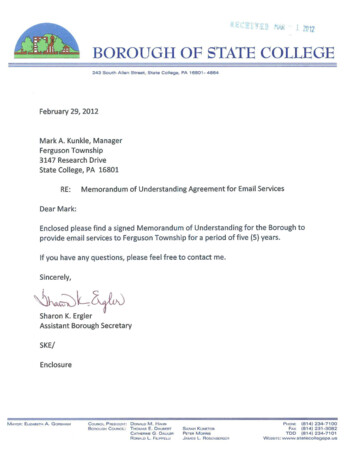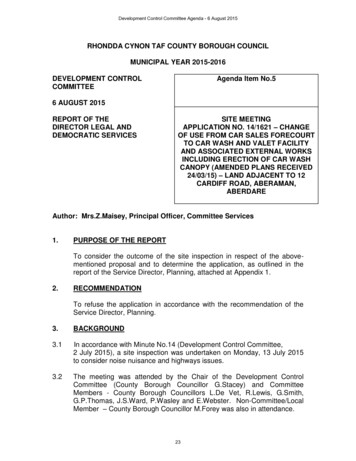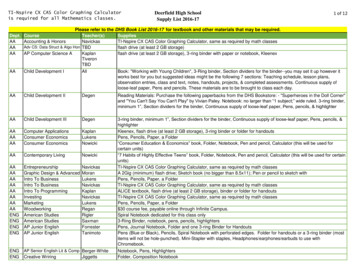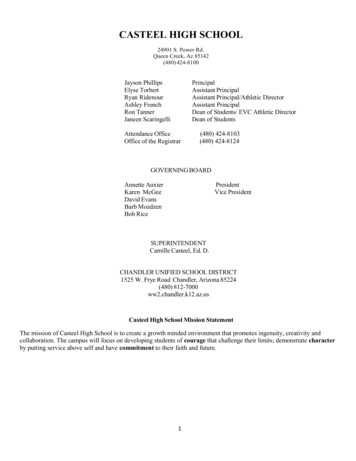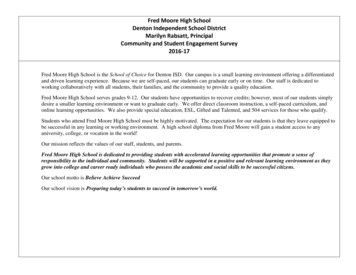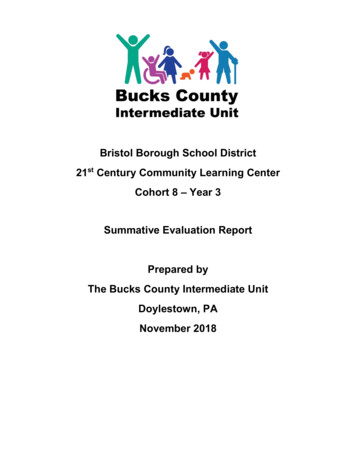
Transcription
Bristol Borough School District21st Century Community Learning CenterCohort 8 – Year 3Summative Evaluation ReportPrepared byThe Bucks County Intermediate UnitDoylestown, PANovember 2018
OverviewBristol Borough School District (BBSD), in partnership with the Advisory OversightCommittee of Bristol Borough (AOC), received funding through the 21st CenturyCommunity Learning Center (CLC) Cohort 8 grant in January 2016. Programming tookplace at three sites: Snyder-Girotti Elementary School, Bristol Borough Middle/HighSchool (BBHS), and St. Mark Catholic School. BBSD is an eligible Schoolwide Title 1district where all at-risk students may participate in programs. Priority is given tostudents in grades K through 12 enrolled in public and parochial schools and whosefamilies reside in the district. The Cohort 8 grant aims to serve a large number ofstudents across the three sites.The grant serves a community with low annual income and low educational attainment.The educational attainment of adults in the communities served is lower than the rest ofBucks County, and the average per capita income is well below the Bucks Countyaverage.Important and noteworthy components of this Bristol Borough School District Cohort 8three-school collaboration, as stated in the overview narrative of the grant application,are the strategies that past Bucks County 21st Century CLC cohorts have used tosupport student achievement. These successful practices for increasing positivestudent behaviors and achievement are:1. The application and use of research-based instructional and learning strategiesfor increasing both student achievement and engagement.2. Consistent program monitoring and evaluation by Bucks County IntermediateUnit (Bucks IU).3. Implementation of ongoing staff development and rigorous hiring practices tosupport high rates of staff and program leadership retention.4. A conscious and purposeful effort to recruit and select instructors, sitecoordinators, and program leadership from surrounding schools and community.The Bristol Borough School District Cohort 8 grant includes the following PA FundingPriorities as frameworks for its program planning and activities at the Snyder-GirottiElementary, Bristol Borough Middle/High, and St. Mark School sites:2
STEM/STEAM: A variety of STEM/STEAM activities, such as Challenge Zones,afterschool STEM clubs, afterschool STEM and Garden Club, Summer STEAMCamp, math enrichment lessons tied to curriculum concepts, and offering STEMrelated seminars to students. Credit Recovery: This program was offered during the summer and school yearand allowed students to combine face-to-face study sessions with certifiedteachers and with online lessons tailored to meet individual needs and creditdeficiencies. College & Career Readiness: Overall, the intent of the grant is to offer collegeand career readiness opportunities to high school students. Student activities thatincreased career awareness and readiness included a Workplace ReadinessProgram, Model United Nations, Fine Arts Club, and Chemistry and Math clubs,among others.Members of the Bucks IU evaluation team, Dr. Rachel Holler, Ronald Rolon, JamesLoGiudice, Dr. Suzanne Laverick-Stone, Kevin Munnelly and Paul Beltz, collected andanalyzed data derived from onsite observations and interviews with students, staff,parents, and Cohort community partners. July 11, 2017: Dr. Suzanne Laverick-Stone and Jim LoGiudice conductedobservations of Credit Recovery and the Garden Club at Bristol Borough and thesummer camp at Snyder-Girotti schools. July 17, 2017: Dr. Suzanne Laverick-Stone, Jim LoGiudice and Ron Rolonconducted observations of the high school program. October 16, 2017: Jim LoGiudice, Ron Rolon and Paul Beltz conductedobservations at St. Mark Catholic School. Ron Rolon visited the program atSnyder-Girotti Elementary School, and Paul Beltz and Jim LoGiudice visitedBristol Borough Middle/High School. December 12, 2017: Jim LoGiudice and Kevin Munnelly conducted observationsat Snyder-Girotti Elementary School and Bristol Borough Middle/High School.3
January 10, 2018: Dr. Suzanne Laverick-Stone, Kevin Munnelly and Paul Beltzvisited programs at Bristol Borough High School and St. Mark School. January 24, 2018: Jim LoGiudice, Paul Beltz, Kevin Munnelly, and Ron Rolonattended a meeting with Darletta Berry Johnson and the site coordinators fromeach of the three sites to discuss current status of the implementation of thegrants. April 5, 2018: Jim LoGuidice and Paul Beltz conducted observations at SnyderGirotti and Bristol Borough High School. Also, a meeting was held with Mr. GeneWilliams, Executive Director of the AOC, to discuss the AOC communityinvolvement and support. The meeting was also attended by the districtsuperintendent and 21st Century staff.Findings—Summer 2017The summer programs for the Bristol Borough School District 21st Century CLC Cohort8 grant began on July 5, 2017 and ended August 10, 2017.Bristol Borough Middle/High SchoolCredit Recovery: This program was designed to support middle and high schoolstudents who needed to master various content for makeup credit. Students wereobserved working on various programs at individual computers, based on their needsfor credit recovery. Students had the choice to work in the school setting or from a homecomputer. One of the support staff instructors for this 6-week program was a teacher ina neighboring school district and a long-time Bristol resident. His presence was anindication of the significant change in the implementation of this cohort in Bristol, in thatthere was increased involvement and employment of several Bristol staff and teachers.Garden Project: Two Bristol High School teachers directed this activity, an ongoingproject for several years that has transformed the school’s courtyard area into a miniworking farm and garden. While 15 students enrolled, regular daily attendance wassparse.Snyder-Girotti Elementary School CLC Summer Camp4
The Bristol Borough Summer Camp served students from grades K through 8 at theSnyder-Girotti School site. This camp (Monday-Thursday) was well attended, with 155students accepted to the program.Campers participated in 1 hour and 40 minutes of academics per day, includingreading/writing, science/social studies, math and the arts. They also had an additional45 minutes of arts instruction and a 45-minute recreational period, which includedsoccer, football, whiffle ball, singing, dancing, etc. The reading instruction was designedto meet the needs of students based on their assessed reading levels. Observedscience lessons included hands-on experiments to emphasize important concepts. Inaddition to reading instruction, students in grades 1-4 participated in a summer bookclub, coordinated with the Grundy Library.Bristol River Theater (BRT) ArtRageous Camp: At the Snyder-Girotti School site, theBristol Riverside Theater (BRT) ArtRageous Camp was offered. As part of the summerprogram, this 21st Century CLC partner-offered camp provided students in grades 2-9with a four-week summer theater program designed to give them the tools to expressthemselves through theater arts while building confidence and self-esteem. Studentswere instructed by professional artists.Students rotated through activities which involved acting, arts and crafts, dance andstage combat. The partnership with BRT is one that both enriches the experience of thestudents and supports the goals of this 21st Century CLC grant.During a site visit, it was noted the school-sponsored drama program had been verylimited, and the ArtRageous program carried over into the school program resulting ingreater participation by students.Discussion with District and Camp Leadership: Jim LoGiudice and Dr. SuzanneLaverick-Stone met with the K-12 principal, Title I administrator and the director of thesummer program. Several pertinent points were discussed: The changing culture and demographics of the district District strategies to address student academic and behavior needs Camp staff recruitment5
Commendations and RecommendationsDistrict, school and 21st Century Cohort 8 leadership took useful steps to address anddecrease the number of students failing courses at the high school. These activitiesincluded: A professional development initiative with the elementary school staff using TheGrowth Mindset in a book club format. Use of failure report data to Partnership and collaboration with the Bucks County Community College in orderto increase student academic expectations and career exploration. Implementation of AVID, a long-range college readiness program to beimplemented by specially-trained teachers. The camp’s staff initiated collaboration with the Grundy Library to increase summerreading and life-long literacy behaviors. Attempts by staff to increase the number of students participating in the GardenProject included individual parent contacts and a parent night.6
Findings—School Year 2017-2018Bristol Borough Middle/High School (BBHS)As the program continued throughout the school year, there was an increase in supportand involvement from the high school staff to urge students to participate. It wasreported that high school staff members were helpful in serving as instructors. Changein site leadership at the Middle/High School during the program year resulted inprogram improvements. Surveys of both students and staff were used to refocus theprogram and determine activities that were meaningful. Attendance increased and amore positive attitude about the program was noted.One unique component of the 21st Century program in Bristol Borough is strong supportfrom the director of the local Bristol Borough Advisory Oversight Committee (AOC) andhis role in assisting with community outreach. This should be noted as a key effort tomeet the Cohort’s outcome of increasing community involvement. The AOC volunteersinclude residents, parents, students, and community stakeholders. The purpose ofthe AOC is to provide year-round programs and services at Learning Centersestablished in Bristol Borough to the youth attending public, parochial, and privateschools. Its mission is to improve academic excellence. In April, the AOC ExecutiveDirector met with Bucks IU evaluation team members, the district superintendent, and21st Century site staff to discuss the ways in which the AOC partnership strengthensprograms for students.Middle/High SchoolCredit Recovery: The mission of the Credit Recovery program is to improve studentachievement and graduation rates which meets the 21st Century Cohort goal of helpingstudents be prepared for college. The Credit Recovery Program at Bristol Borough HighSchool aimed to improve achievement by enabling students to make-up course work forfailing or receiving an incomplete grade, and to increase their chances for graduating ontime. The Credit Recovery program was supported through Edgenuity online coursesoftware.7
It was noted that attendance increases at the end of marking periods when studentsrecognize the need for assistance and improvement.Some areas of the program have been revised to better ensure student success. Forinstance, to increase attendance, students were permitted to utilize the program athome and at school but were required to take quizzes on site.Garden Club: Although this has been an ongoing part of the program since its inceptionduring the 21st Century CLC Cohort 6A grant, student attendance and long-termengagement is a concern.Study Hub: Students met in the library before attending other 21st Century activities.Time was provided to support homework completion.Tutor Crew: This was a student-run tutoring program with sessions for high schoolstudents who needed additional help with academic tasks.Book Club: A high school faculty member conducted reading/discussion activities forhigh school students. Round-table explorations and discussion focused on books thatdealt with societal and current events issues.Workforce Readiness: Two instructors prepared lessons focused on the skills neededby students in order to attain part-time jobs while in school and full-time employmentupon graduation. Activities included, but were not limited to, accessing print and onlinejob listings, completing job applications, writing resumes, role playing interviews,practicing technology applications often required for entry-level positions, and learningpersonal budgeting and financing. This club’s goals met one of the 21st Century CLCCohort 8 grant’s priorities related to career development and job preparedness.Village Arts (Grades 7, 8): Students joined instructors from Village Arts to create piecesof art.Fitness Club: Students had the opportunity to participate in afterschool use of theweight room. This activity was supervised by a school coach.8
Snyder-Girotti Elementary SchoolThe 21st Century program at Snyder-Girotti Elementary School was characterized by astrong connection to the classroom curriculum and instruction. This provided support foracademic goals and objectives in addition to social and emotional goals of the 21stCentury grant. Of special note were the reading and mathematics tutoring programswhich were led by Snyder-Girotti teachers with strong backgrounds in their areas ofinstruction.There was also an emphasis on improving the program at Synder-Girotti which wasexemplified by their use of a consultant to observe the 21st Century programs and makerecommendations for strengthening their work with students.Snyder-Girotti Programs and Activities:Adventure Quest: Time was limited to 25 minutes for students to receive assistancewith assignments from class.Math/Reading Tutoring: M-W Reading, T-Th MathThe reading program offered tutoring and individualized instructional support to differentgroups of students, differentiated by achievement and grade level. Tutoring was held for90 minutes, and student placement was based on the levels of reading or math skills.The instructors utilized the Lexia program to increase reading levels by monitoring theacquisition of increased Lexile levels.Math Scholars: The Math Scholars afterschool program was for students whostruggled to master basic math skills. The learning activities in this program centered onassisting students to meet the assessment of the Pennsylvania Core Standards in Math.Small group instruction was aimed at increasing academic achievement in both mathand other related STEM content areas and was able to target individual student’sstrengths and weaknesses. It was the intent of this program to measure studentprogress and outcomes via pre/post assessment of math facts. A Snyder-Girottiteacher/math specialist provided this tutoring for students with an emphasis onconnection to grade level standards and congruency with classroom objectives andinstruction.Village Arts (Grades 4-6): This special activity was provided by the grant partner,Village Arts, which provided tailored art experiences for children and adults. The intent9
of the art program was to promote creativity through the visual arts by engagingstudents in hands-on activities and expression. Knowledgeable instructors providedlearning about color in the real world, how to blend color, and how colors make us feel.These learnings then connected to other academic art curricula.Sound Science (Grades 1-3): These activities were held for first to third graders tolearn about how sounds are made, how we hear them, and how to design their owninstruments and use them to make various sounds, furthering their understanding ofSTEM concepts.STREAM: Coordinators and monitors prepared STREAM activities for students.Robotics (Grades 6, 7 at St. Marks and Grade 6 at Snyder-Girotti): Bristol JuniorRobotics Club was for students interested in learning how to build their own robots.Little Builders: This program was designed for second graders to engage in hands-onactivities through building, sanding of wood to make bird houses and other simpleprojects.Knitting Knewbies: Students in grades 4 to 6 learned the basic skills of knitting.Nutrition Mission: The focus of this group was about living a healthy lifestyle. Studentspracticed exercises that can be used daily and used recipes to create easy, healthysnacks. Food for the club was provided by the Bristol Borough AOC.Silver Lake Nature Center: Presentations by Nature Center staff introduced studentsto animals found at the Nature Center.10
21stCentury Program— Bristol Borough School DistrictCohort 8—2017-2018 Teacher Survey DataNote: Data provided to Bucks IU evaluation team by site staffCohort 8 Teacher Survey—Summary of Key Behaviorsrelated to 21stCenturyGrantTarget BehaviorsHomework Completion &Class ParticipationStudent BehaviorTarget BehaviorsHomework Completion &Academic PerformanceStudent Behavior% of studentsrated asdemonstratingimprovementGrades PK to 566%69%Grade 6-1278%86%11
St. Mark Catholic SchoolThe St. Mark School 21st Century CLC Cohort 8 program served 7th and 8th grades.During the first visit of the Bucks IU evaluation team to this Cohort 8 site, the majority ofstudents attending were from the 8th grade. Efforts that were in place to increaseenrollment and regular attendees from other grades have, over the school year, beeneffective.At the St. Mark School, Adventure Quest engaged students daily with Homework Help,small group STREAMS Club (Science, Technology, Revitalization, Engineering, Arts,Math and Scholarship), and group recreation activities. Students used free time toaccess Grundy Library for reading and choosing books. Snacks were provided by theArchdiocese of Philadelphia. Through the Archdiocese’s meal program, these studentshave been introduced to new and healthy foods.The other program offerings included the following:Tutoring: Students were selected based on assessment data to attend small groupsessions of either mathematics or ELA tutoring.Silver Lake Environmental Studies: Students participated in animal adaptationactivities.Calligraphy: Students practiced artistic handwriting skills.Sound Science: Students explored the world of sound by playing instruments andbuilding their own to create a sound unique to them.History Club: This offering took advantage of the rich history of Bristol Borough.Students explored the past through mini research projects, reading and writing poetry,and hands-on activities.Computer Laboratory: In the Mac lab, students used Google Docs to work on projectsand send assignments electronically to teachers. Students also had access to iPads onwhich they use Quizlet, an online academic learning environment.12
Nutrition Mission: The focus of this group was about living a healthy lifestyle. Studentspracticed exercises that can be used daily and used recipes to create easy, healthysnacks. Food for the club was provided by the Bristol Borough AOC.Village Arts: This special activity was provided by the contract-based partner, VillageArts, which provided tailored art experiences for children and adults. The intent of theart program was to promote creativity through the visual arts by engaging students inhands-on activities and expression. Knowledgeable instructors used a variety of mediato create scenes that taught a variety of drawing and painting techniques.Get in the Loop Crocheting: The program was held to help students learn to crochetand develop concepts of mindfulness.Tech Club: Students learned the basics of coding and created games on the computer.13
Commendations and RecommendationsOverall Comments Strong support for the 21st Century program was provided by the superintendent.School district leadership understood and recognized the value of providing activitiesand support that were aimed at increasing student achievement and changingnegative behaviors. This is a focus that is especially needed in a district where manystudents are under-performing and in need of extended and enriched academicsupport. A unique component of the Bristol Borough School District’s 21st Century
Bristol River Theater (BRT) ArtRageous Camp: At the Snyder-Girotti School site, the Bristol Riverside Theater (BRT) ArtRageous Camp was offered. As part of the summer program, this 21st Century CLC partner-offered camp provided students in grades 2-9 with a four-week summer t




